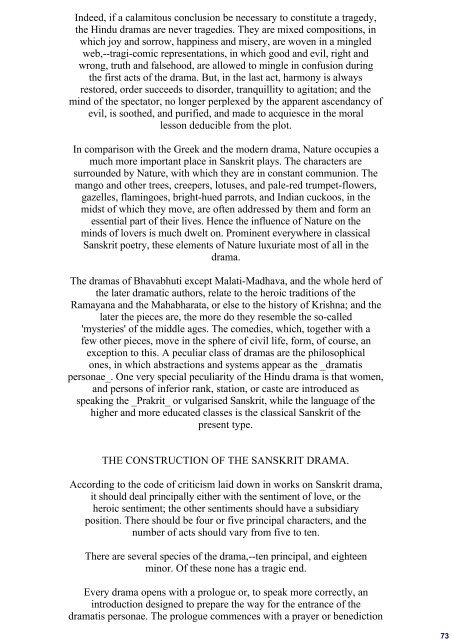TALES FROM THE HINDU DRAMATISTS - Awaken Video
TALES FROM THE HINDU DRAMATISTS - Awaken Video
TALES FROM THE HINDU DRAMATISTS - Awaken Video
You also want an ePaper? Increase the reach of your titles
YUMPU automatically turns print PDFs into web optimized ePapers that Google loves.
Indeed, if a calamitous conclusion be necessary to constitute a tragedy,<br />
the Hindu dramas are never tragedies. They are mixed compositions, in<br />
which joy and sorrow, happiness and misery, are woven in a mingled<br />
web,--tragi-comic representations, in which good and evil, right and<br />
wrong, truth and falsehood, are allowed to mingle in confusion during<br />
the first acts of the drama. But, in the last act, harmony is always<br />
restored, order succeeds to disorder, tranquillity to agitation; and the<br />
mind of the spectator, no longer perplexed by the apparent ascendancy of<br />
evil, is soothed, and purified, and made to acquiesce in the moral<br />
lesson deducible from the plot.<br />
In comparison with the Greek and the modern drama, Nature occupies a<br />
much more important place in Sanskrit plays. The characters are<br />
surrounded by Nature, with which they are in constant communion. The<br />
mango and other trees, creepers, lotuses, and pale-red trumpet-flowers,<br />
gazelles, flamingoes, bright-hued parrots, and Indian cuckoos, in the<br />
midst of which they move, are often addressed by them and form an<br />
essential part of their lives. Hence the influence of Nature on the<br />
minds of lovers is much dwelt on. Prominent everywhere in classical<br />
Sanskrit poetry, these elements of Nature luxuriate most of all in the<br />
drama.<br />
The dramas of Bhavabhuti except Malati-Madhava, and the whole herd of<br />
the later dramatic authors, relate to the heroic traditions of the<br />
Ramayana and the Mahabharata, or else to the history of Krishna; and the<br />
later the pieces are, the more do they resemble the so-called<br />
'mysteries' of the middle ages. The comedies, which, together with a<br />
few other pieces, move in the sphere of civil life, form, of course, an<br />
exception to this. A peculiar class of dramas are the philosophical<br />
ones, in which abstractions and systems appear as the _dramatis<br />
personae_. One very special peculiarity of the Hindu drama is that women,<br />
and persons of inferior rank, station, or caste are introduced as<br />
speaking the _Prakrit_ or vulgarised Sanskrit, while the language of the<br />
higher and more educated classes is the classical Sanskrit of the<br />
present type.<br />
<strong>THE</strong> CONSTRUCTION OF <strong>THE</strong> SANSKRIT DRAMA.<br />
According to the code of criticism laid down in works on Sanskrit drama,<br />
it should deal principally either with the sentiment of love, or the<br />
heroic sentiment; the other sentiments should have a subsidiary<br />
position. There should be four or five principal characters, and the<br />
number of acts should vary from five to ten.<br />
There are several species of the drama,--ten principal, and eighteen<br />
minor. Of these none has a tragic end.<br />
Every drama opens with a prologue or, to speak more correctly, an<br />
introduction designed to prepare the way for the entrance of the<br />
dramatis personae. The prologue commences with a prayer or benediction<br />
73
















